First, LED basics
1, LED lighting principle
LED (Light Emitting Diode) is an abbreviation for LED. A diode made of a compound of gallium (Ga) and arsenic (AS) or phosphorus (P) that emits visible light when electrons and holes recombine, and thus can be used to make a light-emitting diode as an indication in circuits and instruments. Lights, or composed of text or numbers. The gallium arsenide diode emits red light, the gallium phosphide diode emits green light, and the silicon carbide diode emits yellow light. With the advancement of technology, LEDs that emit similar incandescent colors have emerged, which provides a long-life, high-efficiency illumination source for modern lighting. The most valuable is that LED devices have a length of 50,000 to 100,000. Lifetime of more than one hour, suitable for a variety of occasions.
2, the characteristics of LED
The light emitted by the LED is different from the natural light. The spectrum is not continuous and lacks the infrared part. Therefore, unlike incandescent lamps, the heat generated by the LED is not radiated by radiation, but must be transmitted by conduction. This is also called LED. The reason for the light source. LEDs have the following advantages:
Energy efficient: White LED is the most energy efficient white light source device currently known. It only takes a few kWh in a thousand hours (the ordinary 60W incandescent lamp consumes 1 kWh for 17 hours, and the ordinary 10W energy-saving lamp consumes 1 kWh for 100 hours)
Long life: semiconductor chip light, no filament, no glass bubble, not afraid of vibration, not easy to break, the service life can reach more than 50,000 hours (the life of ordinary incandescent lamps is only hundreds of hours, the life of ordinary energy-saving lamps is only eight thousand hour)
Green and environmental protection: It does not contain harmful elements such as mercury and antimony, which is good for recycling and utilization, and does not cause electromagnetic interference. (Ordinary lamps contain elements such as mercury and lead. Electron ballasts in energy-saving lamps generate electromagnetic interference and lamps. Mercury is still present in the tube)
Protected vision: DC drive, no stroboscopic (normal lights are AC drives, it will inevitably produce stroboscopic)
High light efficiency: low heat: 90% of electrical energy is converted into visible light (80% of ordinary incandescent light is converted into heat, and only 20% is converted into light)
The market potential is large: low-voltage, DC power supply, battery, solar power supply, can be used in remote mountain areas and field lighting, such as lack of electricity, less electricity.
According to the prediction of international authoritative organizations, semiconductor light-emitting diode lighting will replace existing traditional light sources in the next 5-10 years. Of course, this will depend on white LEDs being cheaper, and technological advancement will inevitably lead to rapid growth of the overall market capacity. The technicians have found that the LED consumes only 1/10 of the energy of the incandescent lamp and the lifetime is 100 times that of the incandescent lamp. Because LED has the advantages of energy saving, environmental protection, long life and small size, experts call it another leap after the incandescent lamp and fluorescent lamp in the history of human lighting. According to the US Department of Energy's prediction, the complete replacement of traditional lighting devices will start in 2010. Japan, the United States, Europe, South Korea and other countries have officially launched the LED lighting strategic plan. According to reports, this year in the World Expo held in Shanghai, China, many developed countries have used LED as a lighting source. In China, the application of LED is also in a vigorous development stage, but since China does not master the core technology of high-power LED, the domestic is still in the stage of importing semiconductor chips, domestic packaging, so the price is relatively high relative to foreign countries. The application is also slightly affected.
3. Electrical characteristics of LED light-emitting diodes
The LED is in the forward working state. When it reaches its luminous voltage value, the LED starts to emit light. When the voltage is continuously increased, the brightness of the LED light increases sharply. If the voltage is increased slightly, the LED may burn out instantly. It can be seen that the LED belongs to a kind. Current devices, it is this characteristic that determines that LEDs must work safely under constant current conditions. This is the main aspect of LED devices that are inconsistent with other light sources in use, and is also a key factor in the safe use of LEDs. The main points.
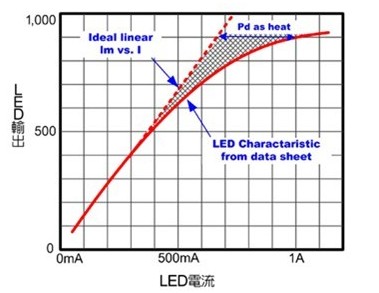
Figure 1 Relationship between forward drive current and output brightness of LED chip with power of 1W
Figure 1 shows the relationship between the forward drive current and the output brightness of an LED chip with a power of 1W. It can be seen that the drive current and the lumen output exhibit a significant linear relationship in the 350 mA range. However, as the forward current increases, a nonlinear relationship gradually emerges between the two. When the drive current exceeds the linear range, the lumen efficiency per watt will decrease, while in the linear range, the lumens produced per watt will show an upward trend. When the drive current exceeds the linear range, the output power is converted from LED to thermal energy. This thermal energy becomes a burden on the LED driver, increases the complexity of the thermal design, and reduces the LED lifetime. Therefore, for a 1W power LED device, the forward drive current does not exceed 350mA. For the currently used Ф5 low-power LED lamp beads, the forward current does not exceed 20mA. For 3W high power LED chips, the forward current should not exceed 700mA.
Second, LED design basis
1, LED drive power design points
According to the characteristics of the LED, the safe use method is to use constant current drive. The constant current drive circuit is characterized in that the output current is constant, and the output DC voltage varies within a certain range according to the magnitude of the load resistance. The load resistance is small, the output voltage is low, the load resistance is larger, and the output voltage is higher.
Careful readers may find that the current products on the market with LED as the main device, mostly using a simple capacitor step-down method, through the capacitor to achieve constant current, such products have a fatal shortcoming, that is often in the switching power supply In an instant, all of the LED devices are burned out at once, because the capacitor is in the capacitance of the differential circuit, the internal resistance of the arc tube is equivalent to the resistance in the differential circuit, and the time parameter of the differential circuit is t. =0.7RC, at the moment of charge and discharge of t, the instantaneous current flowing through the LED is extremely large (possibly reaching tens or times to hundreds of times the normal current), causing instantaneous permanent damage to the chip.
A more reliable LED driver circuit is shown in Figure 2 (more suitable for used LED series applications):
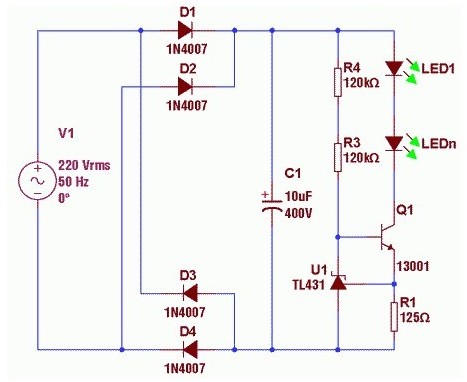
Figure 2: High reliability LED driver circuit diagram
In this circuit, C 1 can be omitted, and U1 can be replaced by an inexpensive ordinary diode. The disadvantage of this circuit is that it is low in efficiency. When tens of (more than 65) lamps are used in series, the efficiency is high. . This circuit can also be simplified. U1 and C1 can be eliminated. The base of Q1 can be directly connected to the lower end of R1. The steady current is determined by 0.6/R1. When R1 takes 30 ohms, the constant current is 20mA.
In theory, LEDs are all diodes that can emit light. In fact, the electrical performance of all LEDs is different. Especially for second-hand LEDs that are easily available to electronic enthusiasts, the threshold Vf of each LED is different, which means that LED The luminous intensity is not exactly the same as the driving current, or the difference is very large. At this time, the designer needs to analyze the actual situation and adopt the most reasonable design scheme to achieve the most effective reliability and economic benefits.
Since LEDs are current-type devices, strictly speaking, only series operation can be used. In parallel operation, the parallel LEDs must be selected. No matter how many tubes are connected in parallel, it is proved that the tube pressure drop must not exceed 0.005V. Otherwise it is easy to cause damage. In the past few years, there have been many flashlights produced in parallel on 7, 9 or even more LEDs in the market. It used to be a sight, but since the appearance of a single tube of 1W, 3W, 5W LED flashlights, this series The flashlight produced by the method has plummeted in price, and almost no one cares about it. I am afraid that it is not entirely the shape of the flashlight. The key is that the technical method is backward and the reliability is the key.
The most ideal LED drive circuit is a PWM constant current control mode switching power supply, which is mainly composed of four parts, an input rectification and filtering part, an output rectification and filtering part, a PWM steady current control part, and a switching energy conversion part. The basic working principle of the PWM switch steady current is that in the case of input voltage, internal parameters and external load changes, the control circuit performs closed-loop feedback by the difference between the control signal and the reference signal to adjust the pulse width of the main circuit switching device. The output current of the switching power supply is stabilized (ie, constant current power supply). The power supply efficiency is extremely high, generally 80% to 90%, and the output current is quite stable. Generally, such circuits have perfect protection measures and are highly reliable power supplies. The disadvantage is that the cost is higher.
2, LED cooling solution
The heat dissipation problem of LED is also a key issue that designers must consider. The light decay of LED is related to the working time and working current of LED and the temperature when LED is working. Under the correct working condition, the working life of LED can reach at least 50,000 hours. Generally, it is very easy to reach 100,000 or even hundreds of thousands. However, if the ambient temperature is too high and the working current is too large, the life of LED will drop sharply. Even causing permanent damage. In general, low-power LED applications do not have to consider the problem of heat dissipation. However, medium-power LEDs with current working currents of 60-150 mA have appeared. At this time, designers are required to consider the heat dissipation problem during normal LED operation. Fortunately, the outer diameter is 8 mm. A white-emitting LED with a working current of 150 mA has a relatively thick pin, and can basically use its thick pins for heat dissipation, but for LEDs with a higher power such as 1 W and above, 3 W, 5 W or even 10 W or more must be used. Adding a heat sink is a normal working environment.

Figure 3: Temperature and current curves of LED light-emitting diodes during operation
Most electronic enthusiasts know that after the PN junction semiconductor device is being turned on, the junction voltage VF drops as the ambient temperature rises, that is, -2mv/°C, which is called the negative temperature effect of the PN junction, and can be used to make the temperature sensor. However, this feature is a fatal flaw in illuminating applications, directly affecting its luminous efficiency. Luminous brightness, illuminating chromaticity. As an example, at 25 °C, the optimal operating current of the LED is 20 mA. When the ambient temperature rises to 85 °C, the junction voltage VF drops and the operating current increases sharply to 35-37 mA. See Figure 3, current curve I, temperature drops to - At 40 ° C, the junction voltage VF rises, the optimum operating current will be reduced by 8-10 mA from 20 mA. The illuminance will also decrease with the decrease of current, which will not reach the illuminance required by the place.
In order to avoid the above-mentioned undesirable phenomena, generally, some measures are required on LED related products. If the LED is mounted on the heat sink, or the fan is cooled by air or the LED is powered by a constant current source, the current will not increase due to the rise of the LED, and the PN junction will be prevented from heating up, or both methods can be used together. Practice has proved that for high-power LED lights (such as advertising background lights, street lights), home radiators are indeed effective measures. However, when LED lights enter the homes of ordinary people, they encounter the following problems: heat sinks, air cooling can be concentrated in a common lamp head space; using constant current source circuits composed of integrated circuits or many components, its life and reliability will be Regardless of the LED, the reliability of the entire system according to the "barrel theory" will depend on some kind of "short board" such as temperature rise.
"Radio" magazine introduced Nanjing Huaju Electronics Co., Ltd. for the LED application developed with a positive temperature coefficient thermistor and negative temperature characteristics of the LED series, forming a temperature coefficient of very small resistance type load is a cheap and good effect s Choice. Once the operating voltage is determined, the current in the series circuit will not change with temperature. In layman's terms, when the LED increases with temperature, the thermistor increases with temperature and the resistance becomes larger, preventing it. The loop current rises. When the LED decreases with temperature and the current decreases, the thermistor also decreases with temperature drop, preventing the loop current from decreasing. When properly matched, the optimum operating current of the LED does not change significantly when the ambient temperature varies from -40 ° C to 85 ° C. See Figure 2 for current curve II. (The current curve II connected to the thermistor is compared with the current curve I without the thermistor.) As can be seen from Figure 1, the thermistor temperature compensation method and the constant current source phase composed of components such as integrated circuits are used. Compared with the same, the biggest difference is that the constant current problem of LED is solved by one component, and its price, volume and life expectancy are self-evident.
The company's positive temperature thermistor WMZD commonly used specifications are shown in Table 1.
Table I
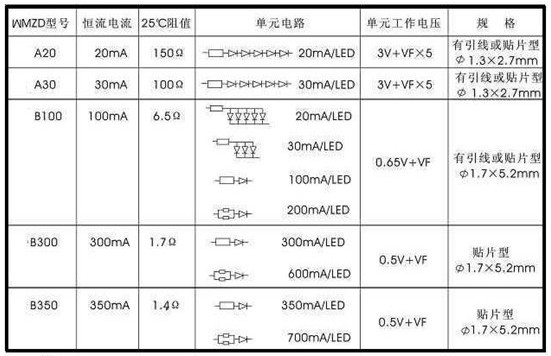
WMZD LED constant current source compensation thermistor can be used in series or in parallel in order to meet the requirements. The reader can flexibly select applications according to the needs to improve reliability.
3, 220V AC LED drive circuit
The sum of the currents of the N-channel unit circuits determines the output current of the DC power supply. For example, a 220V AC/DC-converted DC power supply with a large change in input voltage is considered.

   Basic circuit of LED lamp 220V AC power supply
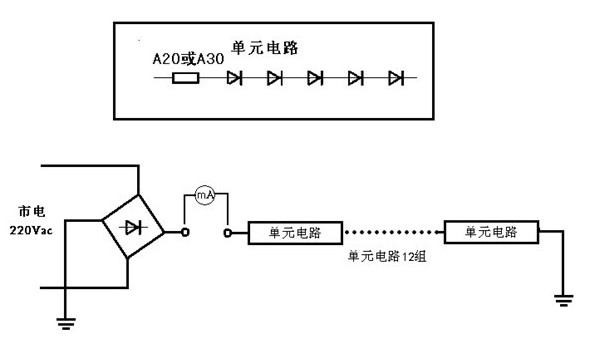
LED lamp 220V AC power supply basic circuit, 220V after 1A bridge rectification, access to the unit circuit consisting of thermistor A20 and 5 LED / 20mA, a total of 12 groups, calculate the working voltage of 12 groups = (3V + 3.3 V × 5) × 12 = 234V, (3V is the voltage drop of 5A20 for constant current, 3.3V is the voltage of LED), the calculated voltage is greater than 220V, can be safely connected to 220V rectifier power supply, the loop current after access should be 18 Between ~20mA, because the LED voltage dispersion is large, between 3.0V~3.6V, if the detection loop current is greater than 20mA, an LED or a 5A20 resistor can be added to reduce the current, otherwise it can be subtracted. An LED that raises the current. The LED lamp consumes 4.5W of power, of which 12 A20s used for constant current consume 0.72W, and 60 LEDs directly used for illumination. The total consumption is 3.78W, and the power conversion efficiency is 84%. The entire set of lamps is close to 8W fluorescent light. The basic circuit of the scheme is simple, reliable, efficient and practical.
After 220V bridge rectification, it is not necessary to connect the parallel wave dielectric capacitors. The LED can drive the illuminating current. The bridge rectified current is 100 continuous sine waves per second. The zero-crossing time is very short and will not feel stroboscopic. . After the parallel capacitors, although the output current is smoothed and filtered, one increases the cost, and the second dielectric capacitor is often in the state of the power-on state, and its lifetime is much lower than that of the LED, so it is not suitable.
4, LED lighting design skills
LED is a cold light source, you can choose colorful plastic cups, coffee cups as lampshades, make decorative cup lights, downlights, table lamps, bedside lamps, and take polyethylene plastic caps, bowls or waste. The disc is cut into a shape matched with the lamp cover for use as a circuit board. When the LED is arranged, the pin is used for perforation positioning, the two legs are inserted, and the opposite side is welded and connected into a circuit. Make cup lights, downlights LED dimming table lamps, cup lamps.
If the circuit above is slightly changed, it becomes an LED DC dimming lamp, as shown below.

The transistor triode 13002 and the 220K potentiometer (with switch) are combined into a dimming resistor. When the lamp is fully lit, the loop current is 20mA, and the 13002 is turned on (voltage drop 0.7v) with no power consumption. When the lamp is half bright, 10mA, 13002 It consumes 0.34W, when the lamp is low, 5mA, and the 13002 consumes 0.26W. The circuit is simple and reliable, the dimming effect is good, and the production cost is extremely low. If there is a white woven lamp dimming table lamp in the home, you can also connect the circuit diagram as shown below. You can turn it into an LED AC dimming lamp without changing the bidirectional thyristor dimming circuit, which is more energy-saving, but the luminosity is weak. . People who are sensitive to light may have a stroboscopic feeling. See the photo in kind 1.
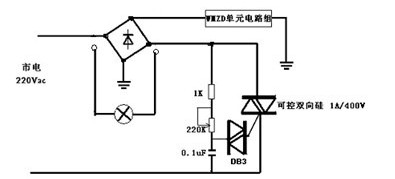
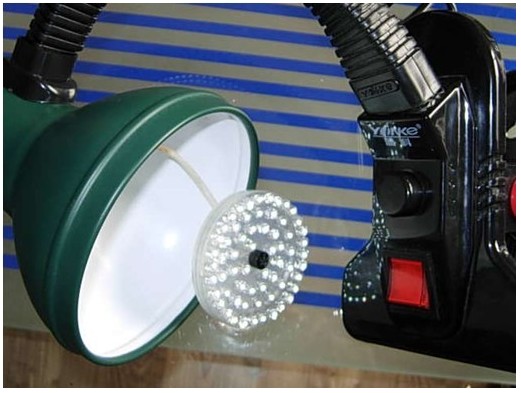
LED fluorescent lamp, ceiling light
As an indoor fluorescent lamp or ceiling light circuit, the brightness of 60 LEDs is equivalent to 8W fluorescent lamps, which is obviously not enough. For example, connecting two LEDs in parallel, with 120 LEDs, can be quite 16w fluorescent lamps. Connected in parallel to three ways, with 180 LEDs, can be quite 25W fluorescent lamps, and so on. Because the mains 220V direct rectification output, the internal resistance of the power supply is very small, any street lamp can be connected in parallel will not cause the rectified output voltage to change, only need to consider the current of the rectifier tube. It is also possible to increase the brightness by using a 30 mA high-brightness LED (such as a piranha) or a 0.3 W/100 mA LED without increasing the number of parallel connections.
LED flashlight
The figure below is for 3.6V. LED flashlight circuit powered by lithium battery, nickel metal hydride battery or 4V dry lead battery.

Use 20mA/3.0V (or 3.4V) LED and 5B100 unit circuit to match the power supply voltage of 3.6V (or 4.0V).
LED car lights
The above LM317 and LM1117 are voltage drop type DC/DC converters. The preferred application is when the input and output voltage difference is small. However, the larger the voltage difference is, the lower the conversion efficiency is. In this case, the switching type DC/DC converter circuit should be selected, and 34063 is a piece. General-purpose, easy-to-buy, low-cost (0.60~0.80 yuan/chip) switch-up and step-down integrated circuits, fewer peripheral circuit components, see the following figure

For automotive LED lights, input voltage 12V, output voltage 1.25~8V adjustable, maximum output current 700mA, select 1W 300mA LED, according to the brightness needs from 1 LED, 2 LED, 4 LED three combinations Optional. Red, yellow and white LEDs can be used to make taillights, turn signals and side lights. When combination 2 and 3 are selected, the working voltage is calculated as 2×(0.5V+VF}, and the resistance of R2 is adjusted to adjust the output voltage to the corresponding calculated voltage value (no load). After the load is connected (full load), increase R2. The resistance value is fine-tuned to 280~300mA. When combination 3 is selected, the current should be fine-tuned to 560~600mA. After R2 is adjusted, the resistance value is prevented from changing and the fixed resistor is used instead.
E-cig as a substitute of tobacco mainly reminds people of its potential benefits for health. Four ingredients contain in the e-liquid : propylene glycol, glycerin vegetable, nicotine and food grade essence. Nevertheless, smoke from cigarette contains carbon monoxide, tar, arsenic, ammonia, and many other cyanide and acetone.
Advantage
- New ceramic self heating element, Uniform heating
- High reduction, Temperaturecan be accurately controlled
- Safety and Health, Worth a product,Natural and realistic taste,Factory Direct Sale
- Using proprietary technology,Quality assurance, trustworthy
- Oil leakage free, compact, pocket-sized, portable and easy to transport
-
So that smokers can smoke addiction, refreshing, to meet the psychological and physiological needs of smokers, and in line with the habit of smokers for many years.
-
Compared with rechargeable e-cigarettes and mechanical e-cigarettes, the price of disposable e-cigarettes is much lower, which is applicable to a wider range of customers than the first two. It is also the absolute truth for ordinary consumer groups to be cheap.
Wax Device Oem,Thc Wax Device Oem,Marijuana Wax Device Oem,High Cost Performance Wax Device
Shenzhen MASON VAP Technology Co., Ltd. , https://www.e-cigarettefactory.com